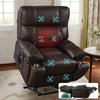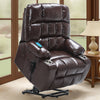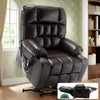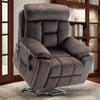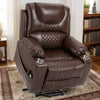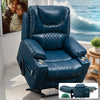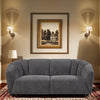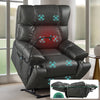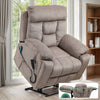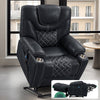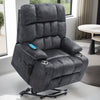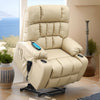Understanding the Mechanics of Power Lift Chairs
The Essentials of Power Lift Chair Functionality
Power lift chairs are innovative devices that aid seniors in standing up and sitting down. They use a motor to tilt and raise the chair, helping users transition from sitting to standing. These chairs have a remote control for easy operation. The lifting mechanism is smooth and gradual, ensuring comfort and safety.

Power lift chairs come in various styles and sizes to suit different needs. They often have multiple positions, including recline and zero-gravity. Some models offer heat and massage features for added comfort. The chairs are designed to blend in with home decor, looking like regular recliners.
The Key Features to Look for in a Power Lift Chair
When choosing a power lift chair, consider these important features:
- Weight capacity: Ensure the chair can support the user's weight
- Seat size: Choose a chair that fits the user comfortably
- Number of positions: More positions offer greater versatility
- Upholstery material: Look for durable, easy-to-clean fabrics
- Battery backup: This feature is crucial during power outages
- Warranty: A good warranty provides peace of mind
Other useful features may include:
- Built-in USB ports for charging devices
- Side pockets for storage
- Adjustable headrest and lumbar support
- Quiet motor operation
How Power Lift Chairs Are Changing the Mobility Game
Power lift chairs are revolutionizing mobility for seniors and those with limited mobility. They promote independence by allowing users to sit and stand without assistance. This reduces the risk of falls and injuries associated with these movements.
These chairs also improve quality of life. They enable users to relax comfortably and easily change positions. This can help alleviate pain and improve circulation. The added comfort encourages users to stay active and engaged, reducing isolation.
Power lift chairs are becoming more advanced. Some now integrate with smart home systems. Others have health monitoring features. These innovations are making power lift chairs an essential part of aging in place strategies.
Power Lift Chairs in the United States: Navigating Regulations and Safety Standards
Safety Standards for Power Lift Chairs
In the United States, power lift chairs must meet strict safety standards. These standards are set by organizations like the American National Standards Institute (ANSI). They cover aspects such as:

- Electrical safety
- Mechanical stability
- Weight capacity
- Fire resistance of materials
The standards ensure that power lift chairs are safe for home use. They address potential hazards like tipping, pinching, and electrical faults. Manufacturers must test their chairs to meet these standards before selling them.
Regular safety checks are recommended for power lift chairs. Users should inspect the chair's mechanisms and wiring periodically. Any signs of wear or damage should be addressed promptly to maintain safety.
Compliance and Certification in the U.S.
Power lift chairs in the U.S. must comply with various regulations. The Food and Drug Administration (FDA) classifies them as medical devices. This means they must meet specific quality control and manufacturing standards.
Manufacturers need to register with the FDA and follow Good Manufacturing Practices (GMP). They must also report any adverse events related to their products. Certification from recognized bodies like UL (Underwriters Laboratories) is often required.
To ensure compliance, look for these certifications:
- FDA registration
- UL listing
- ANSI/BIFMA X5.4 certification for seating
- California TB 117-2013 for fire safety
These certifications indicate that the chair meets necessary safety and quality standards.
The Impact of Regulations on Power Lift Chair Quality
Regulations have significantly improved the quality of power lift chairs. They ensure that chairs meet minimum safety and performance standards. This protects consumers from substandard or dangerous products.
These standards have led to innovations in design and technology. Manufacturers now focus on creating chairs that are both safe and user-friendly. Features like smooth lift mechanisms and stable bases are now common.
Regulations also promote transparency. Manufacturers must provide clear information about their products. This helps consumers make informed decisions when choosing a power lift chair.
However, regulations can also increase costs. Meeting standards requires extensive testing and quality control. This can make power lift chairs more expensive. But the added safety and reliability are generally worth the cost.
Real-Life Applications: Power Lift Chairs in Action
Case Studies: Power Lift Chairs Making a Difference
Power lift chairs have transformed lives across the country. Here are some real-life examples:

- John, 72, with arthritis: A power lift chair helped him regain independence. He can now stand up easily without pain.
- Mary, 65, recovering from hip surgery: Her power lift chair aided in her recovery. It allowed her to change positions safely and comfortably.
- Tom, 80, with Parkinson's: His power lift chair reduced fall risk. The smooth lift mechanism helps him stand steadily.
- Sarah, 70, caregiver for her husband: The power lift chair eased her caregiving duties. It allows her husband to sit and stand with minimal assistance.
These stories show how power lift chairs can improve daily life for seniors and their caregivers.
The Role of Power Lift Chairs in Assisted Living Facilities
Assisted living facilities are increasingly adopting power lift chairs. These chairs offer several benefits:
- Reduced strain on staff: Caregivers don't need to manually lift residents as often
- Increased resident independence: Residents can move more freely without constant help
- Improved safety: The risk of falls during transfers is reduced
- Enhanced comfort: Residents can easily adjust their position for comfort
Many facilities now include power lift chairs in common areas and individual rooms. They're seen as a valuable tool for maintaining resident dignity and independence.
Some facilities report reduced workplace injuries among staff since introducing power lift chairs. This leads to better care and lower operational costs.
Future Trends in Power Lift Chair Technology
The future of power lift chairs looks promising. Several trends are emerging:
- Smart integration: Chairs may connect to home automation systems for voice control
- Health monitoring: Built-in sensors could track vital signs and movement patterns
- Customization: 3D printing may allow for more personalized chair designs
- Improved materials: Lighter, stronger materials could make chairs more portable
- Advanced motors: Quieter, more efficient motors may enhance the user experience
These innovations aim to make power lift chairs even more useful and user-friendly. They could play a larger role in home healthcare and aging in place strategies.
As technology advances, power lift chairs may become more affordable and accessible. This could greatly benefit the growing senior population, enhancing mobility and independence for many.








